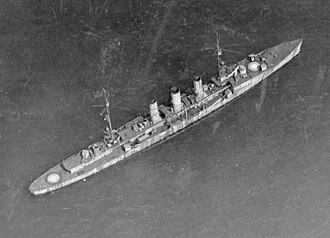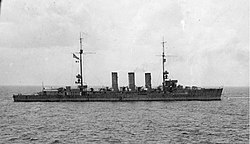 SMS Frankfurt as a bombing target in 1921 | |
| Class overview | |
|---|---|
| Name | Wiesbaden class |
| Builders | |
| Operators | |
| Preceded by | Pillau class |
| Succeeded by | Königsberg class |
| Completed | 2 |
| Lost | 2 |
| General characteristics | |
| Type | Light cruiser |
| Displacement | |
| Length | 145.30 m (476 ft 8 in) |
| Beam | 13.90 m (45 ft 7 in) |
| Draft | 5.76 m (18 ft 11 in) |
| Installed power |
|
| Propulsion |
|
| Speed | 27.5 knots (50.9 km/h; 31.6 mph) |
| Range | 4,800 nmi (8,900 km; 5,500 mi) at 12 knots (22 km/h; 14 mph) |
| Crew |
|
| Armament |
|
| Armor |
|
The Wiesbaden class of light cruisers was a class of ships built by the German Kaiserliche Marine (Imperial Navy) shortly before the outbreak of World War I. Two ships were built in this class, Wiesbaden and Frankfurt. They were very similar to the preceding design, the Graudenz class, though they were armed with eight 15 cm SK L/45 guns instead of the twelve 10.5 cm SK L/45 guns on the earlier vessels. The ships had a top speed of 27.5 knots (50.9 km/h; 31.6 mph).
Contents
- Design
- Dimensions and machinery
- Armament and armor
- Service history
- Wiesbaden
- Frankfurt
- Footnotes
- References
- Further reading
Wiesbaden saw only one major action, the Battle of Jutland, on 31 May – 1 June 1916. She was badly damaged and immobilized during the battle and became the center of a melee as both sides fought over the crippled ship. She eventually sank in the early morning hours of 1 June, with only one survivor. Frankfurt was only lightly damaged at Jutland and saw extensive service with the II Scouting Group, including during Operation Albion against the Russians in the Baltic and at the Second Battle of Heligoland Bight, both in 1917. She was interned with the rest of the fleet at the end of the war and scuttled at Scapa Flow, though British sailors prevented her from sinking. Frankfurt was ceded to the US Navy as a war prize and eventually expended as a target in July 1921.
